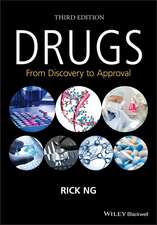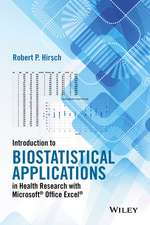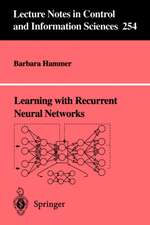Similarity-Based Clustering: Recent Developments and Biomedical Applications: Lecture Notes in Computer Science, cartea 5400
Editat de Thomas Villmann, M. Biehl, Barbara Hammer, Michel Verleysenen Limba Engleză Paperback – 2 iun 2009
Din seria Lecture Notes in Computer Science
- 20%
 Preț: 1061.55 lei
Preț: 1061.55 lei - 20%
 Preț: 307.71 lei
Preț: 307.71 lei - 20%
 Preț: 438.69 lei
Preț: 438.69 lei - 20%
 Preț: 645.28 lei
Preț: 645.28 lei -
 Preț: 410.88 lei
Preț: 410.88 lei - 15%
 Preț: 580.46 lei
Preț: 580.46 lei - 17%
 Preț: 427.22 lei
Preț: 427.22 lei - 20%
 Preț: 596.46 lei
Preț: 596.46 lei -
 Preț: 449.57 lei
Preț: 449.57 lei - 20%
 Preț: 353.50 lei
Preț: 353.50 lei - 20%
 Preț: 1414.79 lei
Preț: 1414.79 lei - 20%
 Preț: 309.90 lei
Preț: 309.90 lei - 20%
 Preț: 583.40 lei
Preț: 583.40 lei - 20%
 Preț: 1075.26 lei
Preț: 1075.26 lei - 20%
 Preț: 310.26 lei
Preț: 310.26 lei - 20%
 Preț: 655.02 lei
Preț: 655.02 lei - 20%
 Preț: 580.93 lei
Preț: 580.93 lei - 20%
 Preț: 340.32 lei
Preț: 340.32 lei - 18%
 Preț: 938.83 lei
Preț: 938.83 lei - 20%
 Preț: 591.51 lei
Preț: 591.51 lei - 15%
 Preț: 438.59 lei
Preț: 438.59 lei - 20%
 Preț: 337.00 lei
Preț: 337.00 lei -
 Preț: 389.48 lei
Preț: 389.48 lei - 20%
 Preț: 607.39 lei
Preț: 607.39 lei - 20%
 Preț: 1024.44 lei
Preț: 1024.44 lei - 20%
 Preț: 579.30 lei
Preț: 579.30 lei - 20%
 Preț: 763.23 lei
Preț: 763.23 lei - 20%
 Preț: 453.32 lei
Preț: 453.32 lei - 20%
 Preț: 575.48 lei
Preț: 575.48 lei - 20%
 Preț: 585.88 lei
Preț: 585.88 lei - 20%
 Preț: 825.93 lei
Preț: 825.93 lei - 20%
 Preț: 763.23 lei
Preț: 763.23 lei - 17%
 Preț: 360.19 lei
Preț: 360.19 lei - 20%
 Preț: 1183.14 lei
Preț: 1183.14 lei - 20%
 Preț: 340.32 lei
Preț: 340.32 lei - 20%
 Preț: 504.57 lei
Preț: 504.57 lei - 20%
 Preț: 369.12 lei
Preț: 369.12 lei - 20%
 Preț: 583.40 lei
Preț: 583.40 lei - 20%
 Preț: 343.62 lei
Preț: 343.62 lei - 20%
 Preț: 350.21 lei
Preț: 350.21 lei - 20%
 Preț: 764.89 lei
Preț: 764.89 lei - 20%
 Preț: 583.40 lei
Preț: 583.40 lei - 20%
 Preț: 649.49 lei
Preț: 649.49 lei - 20%
 Preț: 341.95 lei
Preț: 341.95 lei - 20%
 Preț: 238.01 lei
Preț: 238.01 lei - 20%
 Preț: 538.29 lei
Preț: 538.29 lei
Preț: 383.93 lei
Nou
Puncte Express: 576
Preț estimativ în valută:
73.47€ • 76.86$ • 61.03£
73.47€ • 76.86$ • 61.03£
Carte tipărită la comandă
Livrare economică 02-16 aprilie
Preluare comenzi: 021 569.72.76
Specificații
ISBN-13: 9783642018046
ISBN-10: 3642018041
Pagini: 214
Ilustrații: XI, 203 p.
Dimensiuni: 155 x 235 x 13 mm
Greutate: 0.32 kg
Ediția:2009
Editura: Springer Berlin, Heidelberg
Colecția Springer
Seriile Lecture Notes in Computer Science, Lecture Notes in Artificial Intelligence
Locul publicării:Berlin, Heidelberg, Germany
ISBN-10: 3642018041
Pagini: 214
Ilustrații: XI, 203 p.
Dimensiuni: 155 x 235 x 13 mm
Greutate: 0.32 kg
Ediția:2009
Editura: Springer Berlin, Heidelberg
Colecția Springer
Seriile Lecture Notes in Computer Science, Lecture Notes in Artificial Intelligence
Locul publicării:Berlin, Heidelberg, Germany
Public țintă
ResearchCuprins
I: Dynamics of Similarity-Based Clustering.- Statistical Mechanics of On-line Learning.- Some Theoretical Aspects of the Neural Gas Vector Quantizer.- Immediate Reward Reinforcement Learning for Clustering and Topology Preserving Mappings.- II: Information Representation.- Advances in Feature Selection with Mutual Information.- Unleashing Pearson Correlation for Faithful Analysis of Biomedical Data.- Median Topographic Maps for Biomedical Data Sets.- Visualization of Structured Data via Generative Probabilistic Modeling.- III: Particular Challenges in Applications.- Learning Highly Structured Manifolds: Harnessing the Power of SOMs.- Estimation of Boar Sperm Status Using Intracellular Density Distribution in Grey Level Images.- HIV-1 Drug Resistance Prediction and Therapy Optimization: A Case Study for the Application of Classification and Clustering Methods.
Textul de pe ultima copertă
This book is the outcome of the Dagstuhl Seminar on "Similarity-Based Clustering" held at Dagstuhl Castle, Germany, in Spring 2007.
In three chapters, the three fundamental aspects of a theoretical background, the representation of data and their connection to algorithms, and particular challenging applications are considered. Topics discussed concern a theoretical investigation and foundation of prototype based learning algorithms, the development and extension of models to directions such as general data structures and the application for the domain of medicine and biology.
Similarity based methods find widespread applications in diverse application domains, including biomedical problems, but also in remote sensing, geoscience or other technical domains. The presentations give a good overview about important research results in similarity-based learning, whereby the character of overview articles with references to correlated research articles makes the contributions particularly suited for a first reading concerning these topics.
In three chapters, the three fundamental aspects of a theoretical background, the representation of data and their connection to algorithms, and particular challenging applications are considered. Topics discussed concern a theoretical investigation and foundation of prototype based learning algorithms, the development and extension of models to directions such as general data structures and the application for the domain of medicine and biology.
Similarity based methods find widespread applications in diverse application domains, including biomedical problems, but also in remote sensing, geoscience or other technical domains. The presentations give a good overview about important research results in similarity-based learning, whereby the character of overview articles with references to correlated research articles makes the contributions particularly suited for a first reading concerning these topics.










